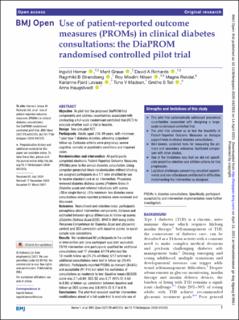Use of patient-reported outcome measures (PROMs) in clinical diabetes consultations: the DiaPROM randomised controlled pilot trial
| dc.contributor.author | Hernar, Ingvild | |
| dc.contributor.author | Graue, Marit | |
| dc.contributor.author | Richards, David A | |
| dc.contributor.author | Strandberg, Ragnhild Bjarkøy | |
| dc.contributor.author | Nilsen, Roy Miodini | |
| dc.contributor.author | Rekdal, Magne | |
| dc.contributor.author | Løvaas, Karianne Fjeld | |
| dc.contributor.author | Madsen, Tone Vonheim | |
| dc.contributor.author | Tell, Grethe Seppola | |
| dc.contributor.author | Haugstvedt, Anne | |
| dc.date.accessioned | 2021-08-09T11:44:25Z | |
| dc.date.available | 2021-08-09T11:44:25Z | |
| dc.date.created | 2021-04-20T14:12:12Z | |
| dc.date.issued | 2021 | |
| dc.identifier.issn | 2044-6055 | |
| dc.identifier.uri | https://hdl.handle.net/11250/2767018 | |
| dc.description.abstract | Objective: To pilot test the proposed DiaPROM trial components and address uncertainties associated with conducting a full-scale randomised controlled trial (RCT) to evaluate whether such a trial is feasible. Design: Two-arm pilot RCT. Participants: Adults aged ≥18–39 years, with minimum 1 year type 1 diabetes duration, attending outpatient follow-up. Exclusion criteria were pregnancy, severe cognitive, somatic or psychiatric conditions and impaired vision. Randomisation and intervention: All participants completed electronic Patient-Reported Outcome Measures (PROMs) prior to the annual diabetes consultation. Using computer-generated block-randomisation without blinding, we assigned participants in a 1:1 ratio stratified by sex to receive standard care or an intervention. Physicians reviewed diabetes distress scores (Problem Areas In Diabetes scale) and referred individuals with scores ≥30 or single item(s) ≥3 to minimum two diabetes nurse consultations where reported problems were reviewed and discussed. Outcomes: Recruitment and retention rates; participants perceptions about intervention components. Variance and estimated between-group differences in follow-up scores (Diabetes Distress Scale (DDS), WHO 5-Well-being Index, Perceived Competence for Diabetes Scale and glycaemic control) and DDS correlation with baseline scores, to assist sample size calculations. Results: We randomised 80 participants to the control or intervention arm (one participant was later excluded). 23/39 intervention arm participants qualified for additional consultations and 17 attended. 67/79 attended the 12-month follow-up (15.2% attrition); 5/17 referred to additional consultations were lost to follow-up (29.4% attrition). Participants reported PROMs as relevant (84.6%) and acceptable (97.4%) but rated the usefulness of consultations as moderate to low. Baseline mean±SD DDS score was 2.1±0.69; DDS SD was 0.71 (95% CI: 0.60 to 0.86) at follow-up; correlation between baseline and follow-up DDS scores was 0.8 (95% CI: 0.7 to 0.9). Conclusions: The pilot trial revealed need for intervention modifications ahead of a full-scale trial to evaluate use of PROMs in diabetes consultations. Specifically, participant acceptability and intervention implementation need further investigation. | en_US |
| dc.language.iso | eng | en_US |
| dc.publisher | BMJ Publishing Group | en_US |
| dc.rights | Navngivelse-Ikkekommersiell 4.0 Internasjonal | * |
| dc.rights.uri | http://creativecommons.org/licenses/by-nc/4.0/deed.no | * |
| dc.subject | Diabetes støtte til egenmestring | en_US |
| dc.subject | Diabetes self-mangement support | en_US |
| dc.subject | Diabetes | en_US |
| dc.subject | Diabetes | en_US |
| dc.title | Use of patient-reported outcome measures (PROMs) in clinical diabetes consultations: the DiaPROM randomised controlled pilot trial | en_US |
| dc.type | Journal article | en_US |
| dc.type | Peer reviewed | en_US |
| dc.description.version | publishedVersion | en_US |
| dc.rights.holder | Copyright Author(s) (or their employer(s)) 2021. | en_US |
| dc.source.articlenumber | e042353 | en_US |
| cristin.ispublished | true | |
| cristin.fulltext | original | |
| cristin.qualitycode | 1 | |
| dc.identifier.doi | 10.1136/bmjopen-2020-042353 | |
| dc.identifier.cristin | 1905337 | |
| dc.source.journal | BMJ Open | en_US |
| dc.subject.nsi | VDP::Endokrinologi: 774 | en_US |
| dc.subject.nsi | VDP::Endocrinology: 774 | en_US |
| dc.subject.nsi | VDP::Endokrinologi: 774 | en_US |
| dc.subject.nsi | VDP::Endocrinology: 774 | en_US |
| dc.identifier.citation | BMJ Open. 2021, 11, e042353. | en_US |
| dc.source.volume | 11 | en_US |

